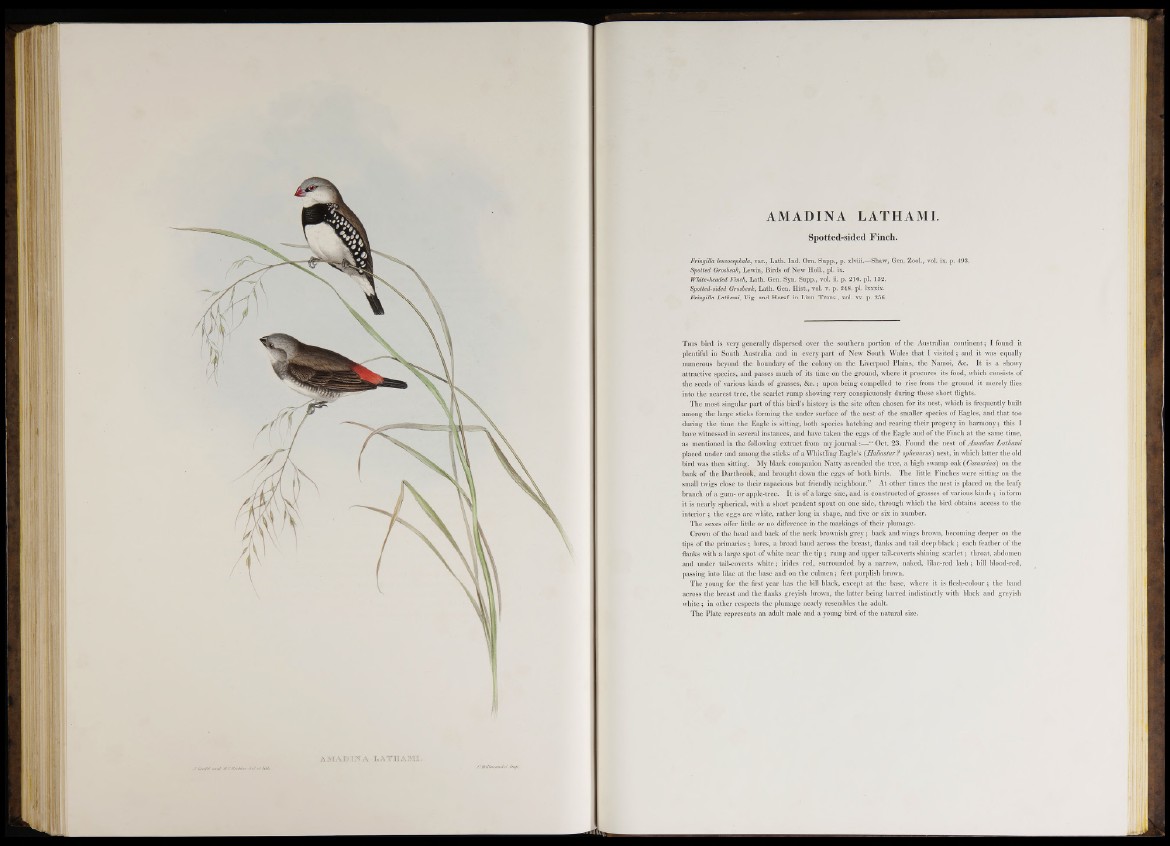
AMADINA LATHAMI.
Spotted-sided Finch.
Fringilla leucocephala, var., Lath. Ind. Orn. Supp., p. xlviii.—Shaw, Gen. Zool., vol. ix. p. 493.
Spotted Grosbeak, Lewin, Birds of New Holl., pi. ix.
White-headed Finch, Lath. Gen. Syn. Supp., vol. ii. p. 210. pi. 132.
Spotted-sided Grosbeak, Lath. Gen. Hist., vol. v. p. 248. pi. lxxxix.
Fringilla Lathami, Vig. and Horsf. in Linn. Trans., vol. xv. p. 256.
T h i s bird is very generally dispersed over the southern portion o f the Australian continent; I found it
plentiful in South Australia and in every part of New South Wales that I visited ; and it was equally
numerous beyond the boundary o f the colony on the Liverpool Plains, the Namoi, &c. I t is a showy
attractive species, and passes much of its time on the ground, where it procures its food, which consists of
the seeds o f various kinds of grasses, & c.; upon being compelled to rise from the ground it merely flies
into the nearest tree, the scarlet rump showing very conspicuously during these short flights.
The most singular p a rt of this bird’s history is the site often chosen for its nest, which is frequently built
among the large sticks forming the under surface o f the nest of the smaller species o f Eagles, and th at too
during the time the Eagle is sitting, both species hatching and rearing their progeny in harmony; this I
have witnessed in several instances, and have taken the eggs o f the E agle and o f the F inch a t the same time,
as mentioned in the following extract from my j o u r n a l “ Oct. 23. Found the nest of Amadina Lathami
placed under and among the sticks o f a Whistling Eagle’s (Haliastur ? sphenurus') nest, in which latter the old
bird was then sitting. My black companion Natty ascended the tree, a high swamp oak ( Casuarina) on the
bank of the Dartbrook, and brought down the eggs of both birds. The little Finches were sitting on the
small twigs close to their rapacious but friendly neighbour.” At other times the nest is placed on the leafy
branch o f a gum- or apple-tree. I t is o f a large size, , and is constructed of grasses of various kinds ; in form
it is nearly spherical, with a short pendent spout on one side, through which the bird obtains access to the
interior ; the eggs are white, rather long in shape, and five or six in number.
The sexes offer little or no difference in the markings o f their plumage.
Crown of the head and back o f the neck brownish g r e y ; back and wings brown, becoming deeper on the
tips o f the primaries ; lores, a broad band across the breast, flanks and tail deep black ; each feather of the
flanks with a large spot o f white near the t ip ; rump and upper tail-coverts shining s c a rle t; throat, abdomen
and under tail-coverts wh ite ; irides red, surrounded by a narrow, naked, lilac-red lash ; bill blood-red,
passing into lilac a t the base and on the culmen; feet purplish brown.
The young for the first year has the bill black, except a t the base, where it is flesli-colour; the band
across the breast and the flanks greyish brown, the latter being barred indistinctly with black and greyish
white ; in other respects the plumage nearly resembles the adult.
The Plate represents an adult male and a young bird of the natural size.